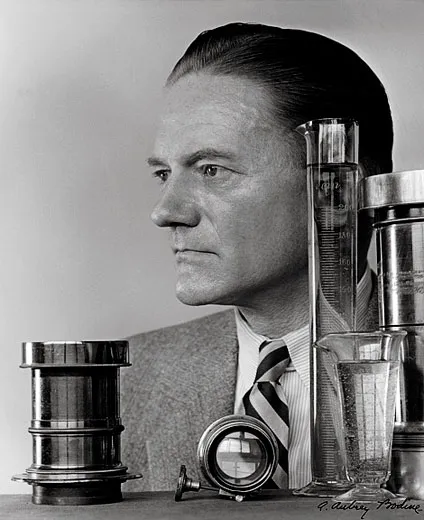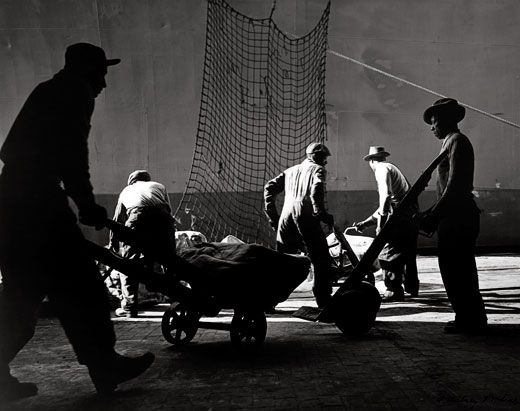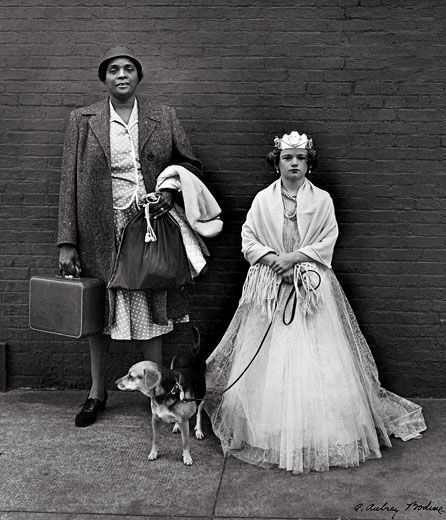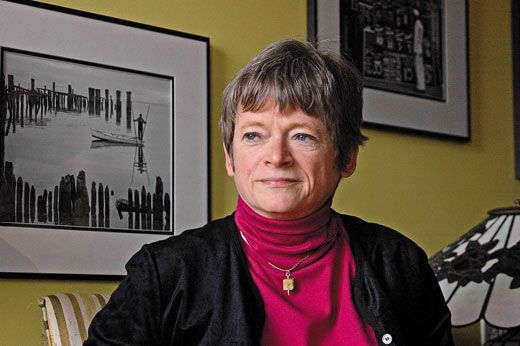Photographing Baltimore’s Working Class
Baltimore’s A. Aubrey Bodine cast a romantic light on the city’s dockworkers in painterly photographs
/https://tf-cmsv2-smithsonianmag-media.s3.amazonaws.com/filer/Indelible-Images-Longshoremen-631.jpg)
The man habitually carried a compass to find the sun on cloudy days; toilet paper to diffuse the light of his flashbulbs; and a machete to deal with unsightly vegetation—and heaven knows what else—that got in his way. But A. Aubrey Bodine once said his favorite tool was his alarm clock.
To take advantage of morning light, the Maryland photographer often rose before dawn and set out for the Baltimore waterfront, where the big freighters might be ferrying sugar, bananas or, as on the day Longshoremen was shot in 1955 at the B&O railroad pier, rubber. “He’d go down there in the middle of the night sometimes, with thousands of dollars of camera equipment,” his daughter Jennifer recalls. “It was a violent, filthy, terrifying place.” But Longshoremen belies the port’s industrial ugliness. With spotlight-like sunshine, it is as elegant as a theater set, the draped cargo net adding the nautical touch that Bodine loved.
The image ran in the Sunday Baltimore Sun, where Bodine, a staff photographer, published almost all his work; it also won prizes in competitions around the world, particularly in the Eastern bloc. Politically, Bodine stood somewhere “to the right of Ivan the Terrible,” according to his editor and biographer, the late Harold Williams, but he shared the communists’ reverence for the worker. Farmers driving yokes of oxen, grimy miners and, especially, dockworkers and watermen—Bodine shot them all. He was an indefatigable laborer himself, taking nearly 50,000 photographs before his death, at age 64, in 1970. In an era when newspaper photos were usually uncredited, Bodine demanded a byline, and before long it was known throughout the state and beyond.
Yet he remained secretive about the initial “A.” It stood for Aldine.
He started at the Sun as a 14-year-old messenger boy in 1920. He caught a break in 1924, when one of the paper’s commercial photographers was scorched in a flash-powder explosion. Even without volatile equipment, photography was a risky enterprise; Bodine loved shooting the Chesapeake Bay, but he couldn’t swim and was forever clinging to the masts of oyster boats, saddled with a large-format camera as heavy as a millstone. Yet he practiced his craft relentlessly, accepting newspaper assignments not only on his wedding morning but on his honeymoon as well. He began shooting primarily for the Sun’s Sunday photography section in 1927 and its Sunday magazine in 1946.
According to even his closest friends, he was not a sociable man. “I do not cover fires or anyone bitten by a dog,” he once declared, apparently oblivious to the feelings of newsroom colleagues who did. One of them remarked that had Bodine drowned on one of his water shoots, his “body would have floated upstream.” Yet he was admired. “He had it all figured out,” says Walter McCardell, who joined the Sun’s photography staff in 1945. “He learned what time the sun rose. I think he knew the tides.” McCardell once tagged along with him on a predawn shoot, “but Bodine didn’t like how the sun was coming up.” After the sun misbehaved for two more mornings, McCardell elected to stay in bed.
Bodine preferred idyllic scenes. He was a pictorialist, part of a photographic movement dating from the late 1800s that favors a painterly aesthetic. Pictorialists freely manipulate their subjects; Bodine thought nothing of removing eyesores, adding props and posing people—including the dockworkers in Longshoremen, according to Kathleen Ewing, author of A. Aubrey Bodine: Baltimore Pictorialist. If he still wasn’t satisfied, the darkroom offered myriad remedies. He was adept at dubbing in sea gulls or brightening the whitecaps on waves. He kept a fishing tackle box full of cloud negatives for enlivening lackluster skies. Some of his practices would be firing offenses at newspapers today, but they were a more acceptable part of feature photography then.
At home, Bodine—which is what even his daughter Jennifer calls him—covered the dining room table with his fresh prints, so the family frequently ate in the kitchen. Gold toner filled the bathtub; the Bodines bathed next door. He was out on assignment throughout Jennifer’s childhood, or so it seemed. When he was home, she prayed he wouldn’t be the one to drive her to a birthday party—too often he would spot a picture on the way and pull the car over, delivering her, pouting in patent leather and crinoline, hours late.
Health problems, including diabetes and hypertension, shadowed Bodine’s later years, but he was undeterred. During one hospital stay, Williams writes, a night watchman discovered him on the roof in his bathrobe, shooting Baltimore’s moonlit skyline. During another, Bodine was found in the lobby, where some of his photographs were displayed. He set about autographing each one until a nurse telephoned the psychiatric ward. “I think one of your patients is down here,” she said, “pretending he’s Aubrey Bodine.”
On the last day of his life he went out to photograph a church spire, another favorite subject, but returned to the office empty-handed, telling editors that the light had “conked out” on him. He then retreated to the darkroom, where he collapsed. He died of a massive stroke.
Jennifer—who named her only child, a girl, Bodine—now spends her time cataloging her father’s endless prints: the record of where he was all those years.
Abigail Tucker is the magazine’s staff writer.
Planning Your Next Trip?
Explore great travel deals
Smithsonian magazine participates in affiliate link advertising programs. If you purchase an item through these links, we receive a commission.



